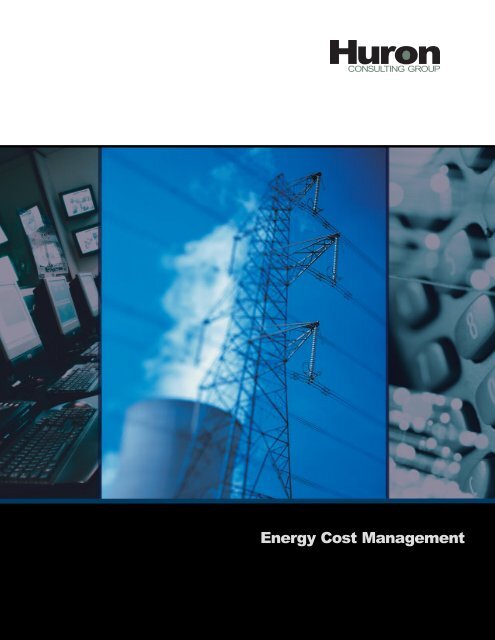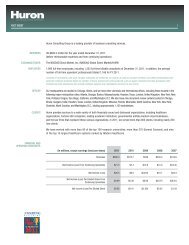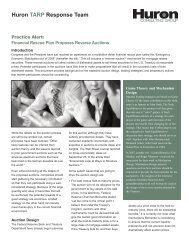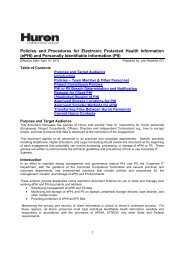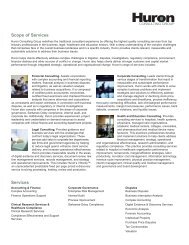Energy Cost Management - Huron Consulting Group
Energy Cost Management - Huron Consulting Group
Energy Cost Management - Huron Consulting Group
Create successful ePaper yourself
Turn your PDF publications into a flip-book with our unique Google optimized e-Paper software.
<strong>Energy</strong> <strong>Cost</strong> <strong>Management</strong>
High and volatile energy prices have andwill continue to increase pressure onoperating margins. A lack ofconcentration on effective energymanagement that addresses multiplefactors contributing to cost has amplifiedthis pressure. <strong>Energy</strong> cost managementstrategies have traditionally focusedprimarily on energy price stabilization, butorganizations are now facing increasedpressure to rationalize consumptionbehaviors and implement effectiveprocurement strategies.Figure 1: Challenges Influencing <strong>Energy</strong> Price in the U.S.Market FactorsCoal MarketChallenges• Coal inventories, which provide half the fuel for electric powergeneration, are down and will take years to rebuild to “normal” levels• Coal-fired generators rely on rail systems to transport coal frommines to plants; consolidation in the rail industry has resulted infewer lines, outdated equipment, shortage of rail cars, andcongestion.• Coal releases large amounts of carbon dioxide, and carbon capscould limit use• Industrial consolidation has reduced spare capacity – major newinvestments are needed• Shortage of coal mining equipment globallyAcross industries, energy inefficienciesexist throughout the operations of anorganization. Some of these inefficienciesmay not be obvious but representsubstantial costs that can be reduced byimplementing a methodical, project-basedenergy cost management program.Comprehensive energy cost managementaddresses three components: (1) energyprocurement, (2) demand management,and (3) energy efficiency, all of which areprudent investments in driving costsavings in a rapidly increasing costcategory.A range of factors are propellingenergy costs to record highs.Crude oil production is near capacity, andthe oil needs of China and India areprojected to soar. Domestically alone, arecent <strong>Energy</strong> Information Administrationreport predicts the demand for energy toincrease 33 percent by the year 2030,with electricity demand rising by morethan 40 percent 1 . Increasing price andvolatility are further influenced by politicalinstability and the decreased value of theU.S. dollar. These issues are expandedupon in Figure 1. Although alternateenergy resources are being vigorouslypursued, at their current state ofdevelopment, they are not a significantenough market force to offset the trend.Natural Gas MarketOil MarketGlobal FactorsInternationalEconomicSocial ResponsibilityInfrastructure• Natural gas wells have a short life; significant drilling activity isrequired to maintain production levels• In this tight market, only price spikes motivate increased drilling,resulting in price volatility• U.S. production peaked in 1973 – increasingly dependent onimports (mostly Canadian)• Additional liquefied natural gas capacity needed, there are onlyfive import facilities in the U.S.• Crude production is near capacity• Markets vulnerable to disruptions – storms, instability, terrorism• Limited refining means competition between refined products –gasoline and distillateChallenges• Global oil and gas prices are increasingly being driven by demandin surging economies like China and India, sending prices soaring• Tensions in oil producing nations like Nigeria and Iran haveincreasingly made investors nervous. Speculators have drivenprices even higher• Slowing global economy, subprime mortgages, write-downs,inflation• Crude-oil trading prices surpassed the $100 per barrel mark on theNew York Mercantile Exchange, driven by weakness in the U.S.dollar and concern about tight supplies• Mandatory renewable portfolio standards established by manyU.S. states• Increased capital expenditures required to “go green”• During the past 25 years, the investment community has focused onreturn from net-assets, rather than expanding the capital base• A focus on productivity has resulted in low costs to the consumer, itdeprives the economy of the resiliency needed to handle fluctuationin demand disruptions (weather, etc.)• Ethanol movement will lead to increased demand on rail and trucksince they cannot use pipelines• Little investment in response to August 2003 blackout in thenortheast area of the U.S. Need for major transmissioninfrastructure investment for reliable electric gridSource: <strong>Huron</strong> <strong>Consulting</strong> <strong>Group</strong>
Implementing an energy costmanagement program can providedirect benefit to an organization’sbottom line.Although there is no “one size fits all”method, organizations are beginning tofind more ways to incorporate energycost management practices into dailyoperations through customized solutionsthat effectively mitigate the challenges.As previously noted, focusing on thethree components of an energy costmanagement program, enablesorganizations to evaluate and improveboth the supply and demand side of theirenergy operations. This framework,outlined in Figure 2, not only providesshort-term results, but positions anorganization for long-term energy costrelief.<strong>Energy</strong> procurement solutions aregenerally the least challenging toimplement, but the most heavilydependent upon external market forces,the structure of an organization’soperating environment, and the energyregulations in the geography of theoperation. <strong>Energy</strong> procurement canfacilitate lower commodity prices andmanage volatility. This function iscommonly outsourced to externalconsultancies with specialized knowledgeof energy purchasing agreements,allowing the organization to remainfocused on their core business.Demand management is an importantarea to develop solid strategies for costsavings, as it provides substantialopportunity to modify consumptionwhile not requiring significant capitalinvestment. The success of alteringconsumption patterns is largelydependent upon an organization’s cultureand the willingness to re-engineeroperations as well as behavior toeliminate energy waste. Potentialopportunities range from reconfiguringbusiness processes to allowingemployees to work remotely.<strong>Energy</strong> efficiency opportunities existwhere excess energy waste can beeliminated from an organization’s physicalinfrastructure. From changing light bulbsto improving building design andmodifying equipment, these opportunitiescan be evaluated in terms of return oninvestment; but can be somewhat limitedby the availability of technology, costof development, and/or the cost ofimplementation. For example, anorganization may not be able to changeor modify equipment due to technologicallimitations in the marketplace or cost ofimplementation. As the global marketadjusts to the new energy landscape,more efficient technologies are expectedto become accessible or provide morereturn on investment as energy pricesclimb.To maximize the impact of an energycost management program, organizationsshould evaluate each of these threecomponents in addressing energy spendand implement those with a clear returnon investment. The solutions anorganization chooses to implement fora successful energy cost managementprogram are uniquely tailored to theorganization’s character, needs, andscale.Figure 2: <strong>Energy</strong> <strong>Cost</strong> <strong>Management</strong> Framework<strong>Energy</strong> Procurement Demand <strong>Management</strong> <strong>Energy</strong> EfficiencyDescription <strong>Energy</strong> cost rationalization <strong>Management</strong> and reduction of energyconsumptionOptimization of operationalcomponents to lessen energyrequirementEffort neededto ImplementLow Medium HighChallenges • Dependent upon client geography • Dependent upon employeesconsciously embracing energyefficient behavior• Business process modificationsmight be required• Dependent upon operationalrequirements and flexibility to changekey components• Technological constraints in replacingcomponents with more efficient ones• <strong>Cost</strong> of development/implementationSteps to Consider• Utility invoice review and audit• Tariff analysis• Commodity aggregation• Business case development• Supplier selection• Reduced customer peak• Reduced total energy demand• Load management• Fuel switching• Distributed energy• Facilities audit• Efficiency strategies• Codes and standards• Process transformation• Sustainable practicesImpact/Benefits• <strong>Cost</strong> savings from lower energyprices• Portfolio view of energy supply anddemand• Fast results• <strong>Cost</strong> savings from lower demand• A thorough understanding of howand where energy is consumed/wasted across an organization• <strong>Cost</strong> savings from increasedefficiencies• <strong>Energy</strong> efficient equipment and/orbuildingsSource: <strong>Huron</strong> <strong>Consulting</strong> <strong>Group</strong>
Considering the state of the energymarket, effective energy costmanagement is essential to anorganization’s success.When evaluating efficient, robust energycost management programs,organizations face significant challenges.A historical lack of emphasis on, andexperience in, energy cost managementcan make identification of savingsopportunities, and implementation ofprograms to capitalize on theseopportunities, complex. However, ignoringthe benefits of energy cost managementprograms, may have a significantnegative effect on an organizationsbottom line.AcknowledgmentsWe gratefully acknowledge the outstandingcontributions to this analysis by DirkVerMeulen, John VerMeulen, Arun Mani,Blake Kelleher, and Christian Cabral.To learn more about <strong>Huron</strong>’s services,please contact Dirk VerMeulen at312-880-3158 ordvermeulen@huronconsultinggroup.com.Members of the media should contact:Jennifer Frost Hennagir312-880-3260jfrost-hennagir@huronconsultinggroup.com1Annual <strong>Energy</strong> Outlook 2008, DOE/EIA-0383 (2008), <strong>Energy</strong> Information Administration, December 2007© 2008 <strong>Huron</strong> <strong>Consulting</strong> <strong>Group</strong> Inc. All rights reserved. 02/08


